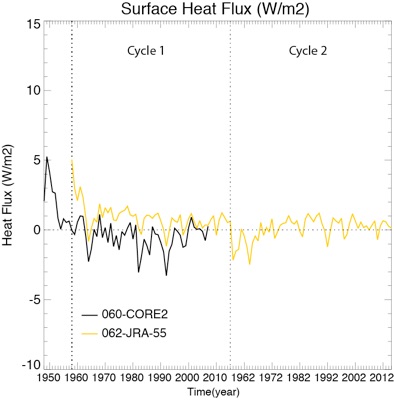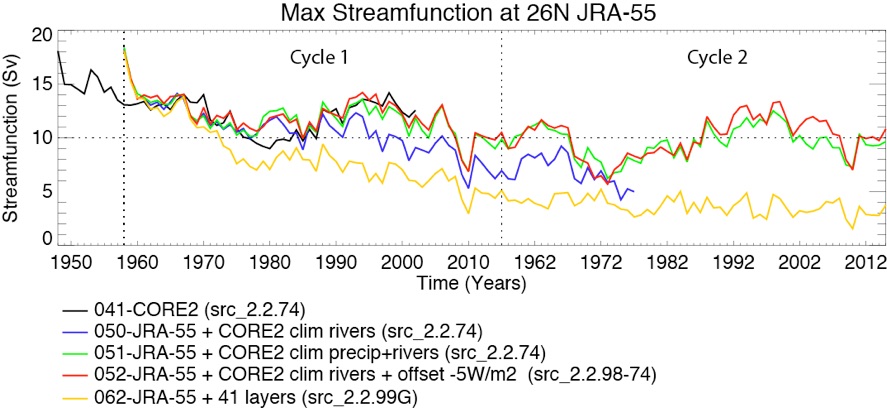Comparison JRA-55 REF vs. JRA-55 CORE2 rivers
-
✓ CORE2 rivers helped a little bit but not enough to keep a reasonable AMOC strength
-
✓ The freshwater content in the Arctic continues to increase without stabilizing in both JRA55-REF and JRA55-Rivers.
-
✓Similar evolution of temperature and salinity at the surface and globally in JRA55-REF and JRA55-Rivers




Comparison HYCOM versions with JRA-55 (1 cycle)

JRA-55 with CORE2 Precip and JRA-55 with Offlux

Old JRa-55 vs. CORE2 Forcing can be found here
!!WARNING!! with CESM 1 JRA-55 cycle is 1958 to 2009
!!WARNING!! with Stand-alone a JRA-55 cycle is 1958 to 2015
!!WARNING!! with CESM 1 JRA-55 cycle is 1958 to 2009
!!WARNING!! with Stand-alone a JRA-55 cycle is 1958 to 2015
-
✓ The total surface heat flux is evening out in the second cycle
JRA-55 with CORE2 Precip and JRA-55 with Offlux with 41 layers





Difference in total heat, SST, radiative, sensible and latent flux between JRA-55 simulations 41 layers-062 and 32 layers-050 (averaged between 1988 and 2007).
-
✓ Difference in total heat , mostly due to larger evaporation with 41 layers overall.
-
✓ Larger evaporation due to warmer SST despite the fact that the overall average of SST is the same between 062 and 050 (yellow vs. blue lines in time series).
Comparison JRA-55 vs. CORE2
-
✓ HYCOM ocean model (version 2.2.99G) coupled with CICE v4.0
-
✓ JRA-55 Forcing 1958-2015 or CORE2 Forcing 1948-2007
-
✓ Initialized from PHC2
-
✓ SSS relaxation of 4 years/50m everywhere except 6 months/50m in Southern Ocean
-
✓ Salt flux normalization
-
✓ No surface relaxation to SST
-
✓ 41 layers


CORE2
JRA-55
-
✓ Wind-stress Magnitude stronger in CORE2, especially in North Atlantic/ Labrador Sea








CORE2
JRA-55
-
✓ Stronger Heat Loss over North Atlantic/Labrador Sea in CORE2


-
✓ Because of the higher heat flux imbalance, global T (and SSH) is increasing faster in JRA-55
-
✓ SST and SSS slightly higher in CORE2


CORE2
JRA-55
-
✓ Similar biases in SSS and SST for CORE2 and JRA-55
-
✓ Except in North Atlantic, with a cool and fresh bias in JRA-55 while CORE2 shows a warm and salty bias
-
✓ Collapse of the AMOC at 26ºN in the first JRA-55 cycle compared with CORE2


CORE2
JRA-55
-
✓ Higher freshwater content in the Arctic in JRA-55
-
✓ Especially high content in the Labrador Sea inhibiting convection events
-
✓ Freshwater content not stabilizing in JRA-55






CORE2
JRA-55
SSMI/IceSat
Ice Cover
Ice Thickness






CORE2
JRA-55
SSMI/IceSat
Ice Cover
Ice Thickness
ARCTIC
ANTARCTIC

-
✓ Better ice cover and thickness with JRA-55 forcing than CORE2 in Arctic and Antarctic







Percentage of wind stress magnitude difference between JRA-55 and CORE2 :
-
✓ JRA-55 is weaker everywhere except the Arctic
-
✓ Especially weaker in the North Atlantic and GIN and Barents Sea
-
✓ JRA-55 wind-stress magnitude is globally around 20% weaker than CORE2 over 1958-2007
-
✓ In the North Atlantic, JRA-55 is around 40% weaker.
FIRST CYCLE
FIRST CYCLE
FIRST CYCLE
FIRST CYCLE

-
✓ Similar vertical distribution of drifts between CORE2 and JRA-55 except:
-
✓ North of 50N with more than 0.3 psu decrease of the salinity over 50 years in JRA-55.
-
✓ Higher positive temperature drift in the Tropics in JRA-55


JRA-55 with CORE2 wind with 41 layers







New JRA-55 with 41 layers



OLD JRA-55
NEW JRA-55 with shear
NEW JRA-55 with NO shear




OLD JRA-55
NEW JRA-55 with shear
NEW JRA-55 with NO shear





